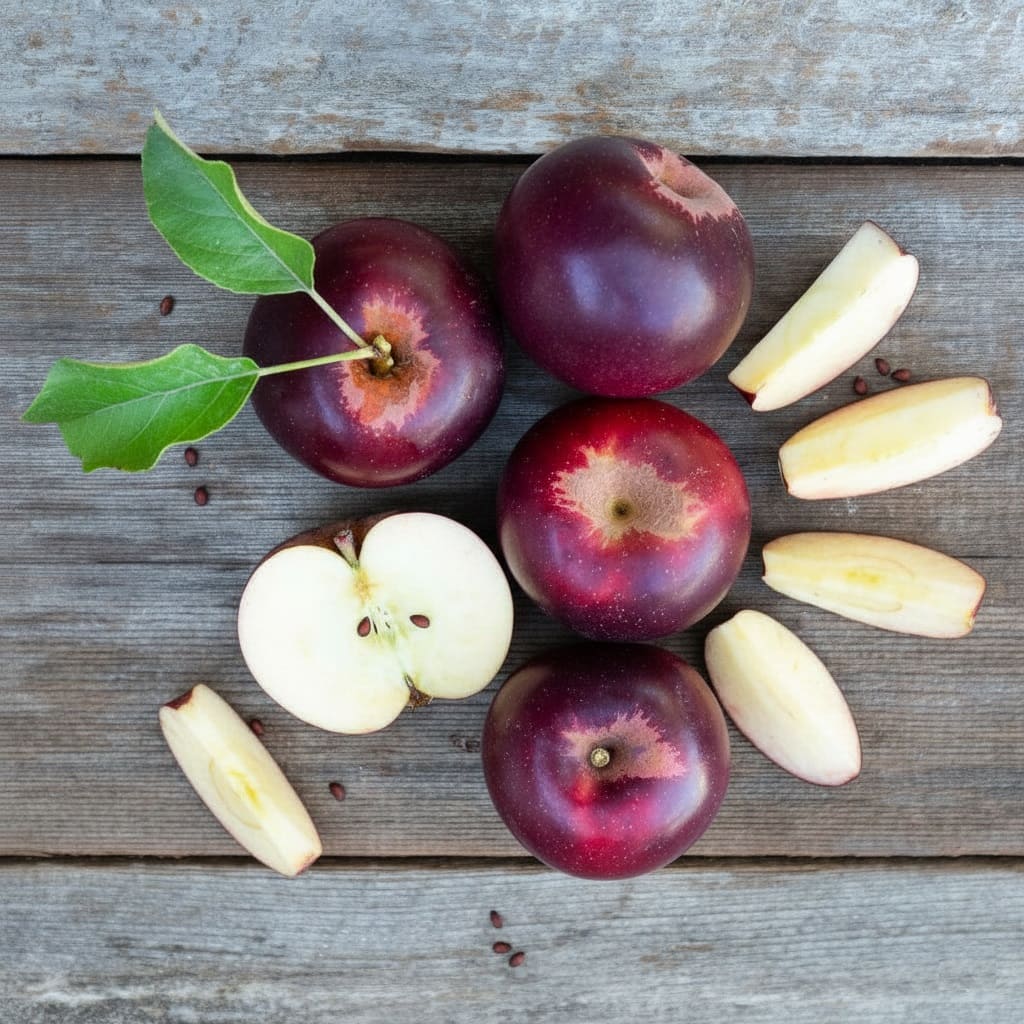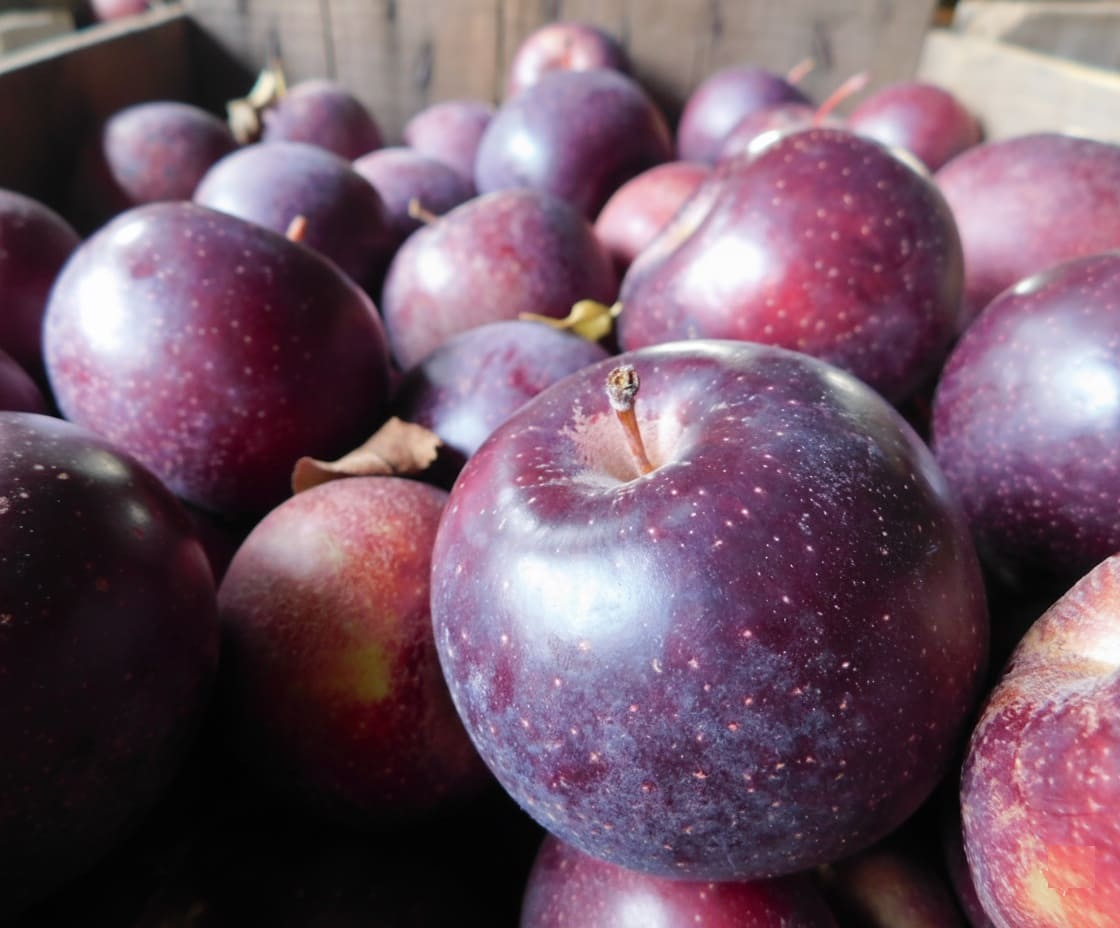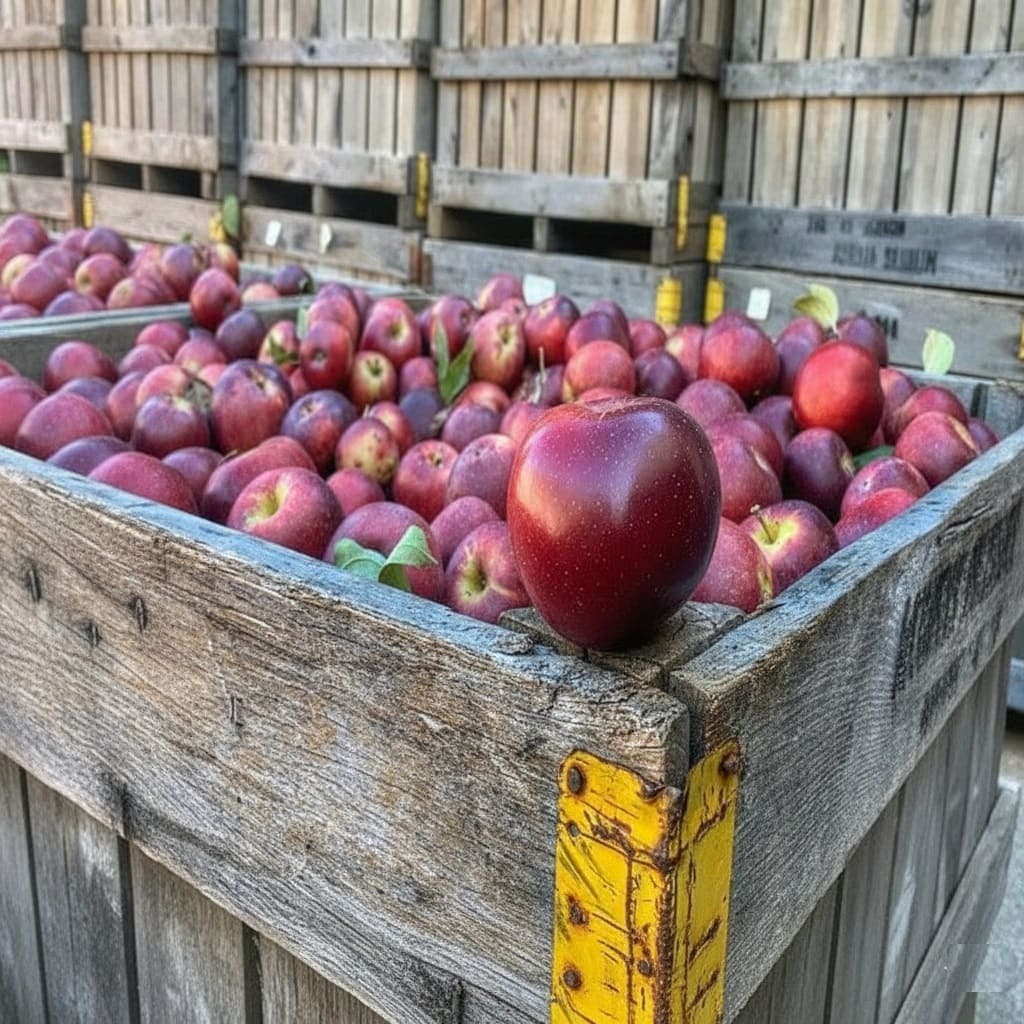Picture this: You’re wandering through a farmers market on a crisp autumn morning when your eyes land on something extraordinary—an apple so deeply colored it appears almost black, like something plucked from a Brothers Grimm tale.
Your first thought might be, “Is this real, or did someone dip it in food coloring?”
Welcome to the fascinating realm of black apples, where patience is rewarded, legends are born, and not everything is quite as it seems.
By the end of this guide, you’ll understand why some of these apples cost $20 each, why others must be stored for months before eating, and how to experience these dark beauties yourself.
Decoding the “Black” in Black Apples
Let’s address the elephant in the room: black apples aren’t actually jet black. They showcase deep burgundy, dark purple, or almost-black crimson hues—think the deepest merlot wine you’ve ever seen.
This striking coloration comes from high concentrations of anthocyanins, the same antioxidant pigments found in blueberries and red cabbage.
Three key environmental factors trigger this dramatic pigmentation:
- Intense ultraviolet light exposure, especially at high altitudes, causes apples to produce protective anthocyanins.
- Cool nights following warm days amplify this effect—the temperature stress encourages deeper color development.
- Finally, direct sunlight is essential; even on the same tree, shaded apples will be noticeably lighter than their sun-exposed neighbors.
Understanding this biology matters because it explains why certain varieties can only achieve their signature darkness in specific locations—and why many online photos have been digitally enhanced beyond reality.
The Black Diamond: Tibet’s Purple Jewel (and Internet Sensation)
The Black Diamond apple has achieved near-mythical status online, with stunning photographs showing apples of an impossibly dark hue. Here’s what’s actually true versus marketing hype.
The Geography and Growing Challenge
Black Diamond apples belong to the Huaniu family (sometimes called Chinese Red Delicious) and grow exclusively in Nyingchi, a mountainous region of Tibet situated at elevations exceeding 11,500 feet.
The extreme conditions—intense UV radiation during the day paired with dramatic nighttime temperature drops to near freezing—create the fruit’s distinctively dark purple skin, while the interior flesh remains bright white.
These apples demand an extraordinary commitment. Trees require up to eight years to reach maturity, then produce fruit for only about two months annually (typically late summer through early fall).
Combined with the challenging high-altitude environment, roughly 30 percent of each year’s crop never makes it to market.
Separating Fact from Fiction
Here’s where things get controversial. While Black Diamond apples are real, many circulating images have been heavily photoshopped to appear pure black rather than their actual deep purple-red.
This digital enhancement has fueled unrealistic expectations and spawned countless “rare black apple” articles that blur the line between fact and fiction.

As for taste, reports from those who’ve actually sampled them describe a pleasant sweetness with crisp texture—but nothing transcendent.
Black Diamonds are primarily sold as luxury gift apples in China and Japan, where rare, beautiful fruits command premium prices regardless of flavor.
In upscale Chinese supermarkets, individual apples sell for $7 to $20 each, often packaged in elegant gift boxes containing just five or six fruits.
The bottom line: Black Diamonds are real, beautiful, and genuinely rare, but they’re not the flavor revelation that marketing suggests, and you’re unlikely to ever taste one unless you visit Tibet or high-end Asian markets.
Arkansas Black: America’s Heritage Dark Apple
While the Black Diamond might be out of reach, there’s wonderful news for American apple enthusiasts: the Arkansas Black offers similar dark beauty with a remarkable story and complex flavor that actually lives up to the hype—if you understand how to handle it.
From Regional Favorite to Near Extinction
The Arkansas Black emerged around 1870 in Benton County, Arkansas, likely as a seedling from the Winesap apple.
During the early twentieth century, when northwest Arkansas was a national apple-growing powerhouse with over 40,000 acres of orchards, this variety accounted for fifteen to twenty percent of the state’s output. In 1900, it even won first prize at the Paris Exposition.
Then came disaster. Codling moth infestations required expensive chemical management just as the Great Depression devastated rural economies. Drought stressed the trees. Arkansas’s apple industry collapsed, and the Arkansas Black nearly vanished.
Today it represents just three to five percent of state production, surviving mainly through small orchards and devoted home growers.

The Crucial Patience Factor
Here’s the detail that separates satisfied Arkansas Black fans from disappointed first-timers: these apples are terrible straight from the tree.
Seriously, rock-hard and unpleasantly sour. Many people try one fresh, hate it, and never give the variety another chance—which is a tragedy.
The transformation happens during storage. Keep Arkansas Blacks in your refrigerator (or a cool cellar at 30-35°F) for at least three months after harvest. As they age, the rock-hard texture softens to a satisfying crisp.
The harsh tartness mellows into a complex sweetness featuring notes of honey, vanilla, cinnamon, almond, and coriander. Some describe the flavor as wine-like, earning it the nickname “the Cabernet of apples.”
This aging ability made Arkansas Blacks invaluable before widespread refrigeration. Families could harvest in October and still enjoy fresh fruit in March. The thick, waxy skin acts as a natural preservative, allowing storage for up to six months.
What to Expect and When to Find Them
Arkansas Black apples are medium-sized with remarkably thick, chewy skin that darkens from deep red to an almost purple-black hue during storage.
The flesh inside is creamy yellow or ivory with a dense, firm texture—quite different from the light, juicy bite of a Honeycrisp.
The variety is remarkably hardy, tolerating both scorching summers over 100°F and winters down to -20°F (USDA zones 4-8). It shows strong resistance to cedar-apple rust and fireblight, though it can be susceptible to apple scab in humid climates.
Look for Arkansas Blacks at farmers markets and roadside stands from late October through February in apple-growing regions, particularly Arkansas, Missouri, Ohio, and parts of the Pacific Northwest and California.
Some growers store them before selling, so always ask whether the apples have been aged already or if you need to do it yourself.
The Broader Black Apple Family
The Arkansas Black isn’t the only dark American apple worth seeking. Black Oxford, a Maine heirloom dating to the 1790s, produces medium-sized fruit with deep purple skin and grows well in colder climates.
It’s excellent for fresh eating from December through March and makes beautiful pink applesauce when cooked with skins on. The original tree, planted in Paris, Maine, was still bearing fruit in 1907—some existing trees are over 200 years old.
King David, developed in Arkansas as a cross involving Arkansas Black genetics, offers deep red coloring and grows well even in warmer climates with good disease resistance.

Other historic varieties like Black Gilliflower, Jersey Black, and Blackmack each have devoted fans, though they’re increasingly difficult to find.
Don’t confuse these true apples with the Australian “Black Apple” (Planchonella australis), a completely different species from the Sapotaceae family—a rainforest tree native to Queensland that happens to produce dark purple-black fruit.
While edible and locally valued, it’s not related to apples (Malus domestica) at all.

Mastering Black Apples in the Kitchen
Once properly aged, Arkansas Black apples and similar varieties become culinary gems. Their firm, dense texture holds up beautifully during cooking, maintaining distinct pieces rather than dissolving into mush.
 Here’s How to Dehydrate Apples at Home: Easy Steps for Perfect Results
Here’s How to Dehydrate Apples at Home: Easy Steps for Perfect Results
For baking, they’re exceptional in pies, crisps, and tarts where you want defined apple chunks with textural integrity. The complex flavor adds depth that single-note sweet apples can’t match.
Try combining them with slightly sweeter varieties like Honeycrisp or Gala for balanced flavor that’s neither too tart nor cloying.
The sweet-tart character shines in savory applications too. Slice them thinly for autumn salads with nuts and sharp cheese, roast them alongside pork or chicken, or incorporate them into stuffing and cornbread where their spice notes complement herbs like sage and thyme.
Black apples create exceptional hard cider, contributing tannic structure and aromatic complexity that cider makers prize for blending.
They also make distinctive apple butter—their flavor intensity means you’ll need less sugar than with milder varieties, and the extended cooking time produces a deep, almost caramelized taste.

For fresh eating, give properly aged Arkansas Blacks a chance at room temperature, when their aromatic compounds are most noticeable.
The dense texture means each bite feels substantial, and the complex flavor unfolds gradually rather than hitting you with simple sweetness.
Growing Your Own: A Long-Term Investment
For the ultimate black apple experience, consider planting your own Arkansas Black tree. It’s available from numerous fruit tree nurseries on various rootstocks: dwarf varieties (8-12 feet tall) or semi-dwarf (12-16 feet).
Key Growing Requirements:
Arkansas Black needs full sun—at least six hours daily for proper fruit coloring and sugar development. It grows in most well-draining soils and, once established, shows good drought tolerance.
The variety is not self-fertile, so you’ll need another apple variety nearby for pollination. Golden Delicious, Gala, Granny Smith, or Fuji all work well as pollinizers. If you’re starting an orchard from scratch, plan for at least two different varieties.
Expect your first small crop 2-4 years after planting, depending on rootstock and growing conditions.
The fruit ripens late—typically early to mid-November in most regions—and should be picked when it feels rock-hard and shows deep red coloring. Don’t worry if it’s not fully black on the tree; the darkening continues during storage.
Plan for minimal pest management compared to many commercial varieties. The thick skin and natural disease resistance mean Arkansas Black typically needs fewer sprays than finicky varieties like Honeycrisp.
However, in humid climates, you may need to manage apple scab with sulfur or other organic controls.
The biggest challenge is patience—both waiting for your tree to mature and then storing the apples for months before eating.
But for those willing to invest the time, Arkansas Black trees can produce for decades, providing a living connection to American agricultural heritage.
Finding and Storing Black Apples
Sourcing Arkansas Blacks
Small orchards and farmers markets in apple-growing regions offer your best chance. In Arkansas, Missouri, and surrounding states, look from late October through winter months.
Some Pacific Northwest, Ohio, and California orchards also grow them on a small scale—call ahead during apple season to check availability.
Several specialty nurseries and orchards ship Arkansas Blacks during season. Expect to pay premium prices plus shipping, but if you’re curious about these distinctive apples, it’s worthwhile for the experience. Some mail-order sources also offer trees for planting.
Storage Essentials
After acquiring Arkansas Blacks, let them rest at room temperature for a few days. This “curing” period allows the skin to toughen, extending storage life.
Inspect each apple carefully—any with deep cuts or bruises should be used immediately in cooking, as they won’t store well.
Store at 30-35°F with high humidity (around 90 percent). A refrigerator crisper drawer works adequately for home storage, though humidity may be slightly lower than ideal. Root cellars provide excellent conditions if you have access to one.
Don’t even think about eating Arkansas Blacks until they’ve been stored for at least three months—mark your calendar for mid-February if you harvest in November.
Check stored apples monthly, removing any that show signs of decay. One spoiling apple can affect others nearby. Properly stored Arkansas Blacks can last four to six months, providing fresh fruit well into late winter or early spring.
Common Questions About Black Apples
- Are black apples more nutritious than regular apples?
The darker skin does contain higher concentrations of anthocyanins, beneficial antioxidants that may support cardiovascular health and reduce inflammation.
However, the overall nutritional profile—including fiber (about 4 grams per apple), vitamin C, and other nutrients—is similar to other apples. They’re healthy, but not dramatically more so than a good Fuji or Gala.
- Why do images of Black Diamond apples look so much darker than reality?
Many viral photos have been digitally enhanced or photoshopped to appear almost pure black rather than their actual deep purple-red.
This creates unrealistic expectations and fuels internet mythology. Real black apples, while impressively dark, always retain visible red or purple undertones.
- Can you eat an Arkansas Black apple right off the tree?
Technically yes, but you won’t enjoy it. Fresh Arkansas Blacks are extremely hard and sour—the aging process is essential for developing their prized flavor and texture. Think of them like fine cheese or wine where time is a crucial ingredient.
- Why don’t grocery stores sell black apples?
Several factors work against commercial production. Arkansas Blacks require storage before sale, adding costs and complexity.
They’re not as productive as modern varieties bred specifically for commercial growing. Trees take longer to bear fruit, and the unique handling requirements make them impractical for mass distribution.
Plus, consumers unfamiliar with the variety might try one too early and have a bad experience, creating negative word-of-mouth.
Your Black Apple Adventure Awaits
Black apples represent something increasingly rare in our age of instant gratification: a food that demands patience and rewards those willing to wait.
They remind us that the best flavors often develop slowly, that appearance can be deceiving, and that heirloom varieties carry stories worth preserving.
The next time someone tells you about a mysterious “black” apple from Tibet that costs $20, you’ll know the full story—the reality behind the hype, why Americans have their own remarkable dark apple that’s actually accessible, and most importantly, why timing matters more than appearance when it comes to truly exceptional flavor.
Ready to start your black apple adventure?
Seek out a local orchard that grows Arkansas Blacks this fall, or browse online nurseries for trees you can plant this season.
Mark your calendar for a three-month wait after harvest, store them properly, and prepare to be surprised by what patience can create. Your taste buds—and your connection to American agricultural heritage—will thank you.
Related posts:
- What Are Pink Pineapples? Everything You Need to Know About This Viral Fruit
- What Is Yellow Watermelon? Taste, Benefits & Varieties
- How to Grow White Strawberries: Pineberry Growing Guide & Care Tips
source https://harvestsavvy.com/black-apples/




No comments:
Post a Comment